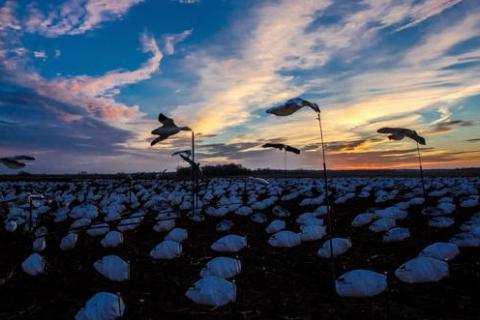
With snow goose populations are out of control, these migrating geese provide untold hunting opportunities for waterfowl hunters. With a basic understanding of these wary birds and how to hunt them, you too can join in this astounding hunting opportunity.
The snow goose dilemma is the perfect example of hunters being needed to help control a menacing wildlife population. Agencies need more hunters to participate in hunting snow geese if they are to ever bring the populations to acceptable levels.
Snow geese are long-lived birds, often living to 15 years or more. They are very wary birds and extremely difficult to hunt, adding to the problem.
How to Get in on the Snow Geese Action
"It sounds like the perfect hunting plan," said Frank Cox, avid snow goose hunter and owner of E-Tech Electronic Callers, in Rolla, Mo. "But, snow geese are very wary and hard to decoy. Traditional waterfowl hunting tactics will not work with snow geese. Snows are very cautious and it takes lots of decoys and calling to get them to commit to your decoy spread. Everything must be perfect and your set must be perfect or the birds will flare. I constantly move decoys and make adjustments until I find what the birds want."
Moving hundreds of decoys around can be a lot of hard work. Instead, Robert Steenbeke, of 1A Hunting in Texas Guide Service Inc., uses a decoy setup which he says works under any conditions.
Below is a typical goose hunting spread layout of a 1A Hunting in Texas Guide Service. Set up this way, it prevents many of the problems associated with getting snow geese to decoy into good shotgun range. I'll explain each part of the decoy spread; what problems that solve; and why it works.
Click here to see a larger view of the Goose hunting Spread Layout graphic.

| Decoy setup used by Robert Steenbeke, of 1A Hunting in Texas Guide Service Inc. |
- This represents the typical feed band that snow geese form when foraging across a field. This is where the hunters should be hidden since it gives you the most decoys per square yard to distract the goose's gaze away from the hunters. In years past, this would be at the downwind edge of the spread instead of the upwind edge, as pictured here. It was done to put the hunters as close to the edge geese were expected to approach from as possible, but the old way of Texas goose hunting is actually backward from what the geese do in the field. I believe they have learned to recognize that unnatural layout as a decoy spread. I also believe that the old layout has encouraged geese to come in through the back door or side door, so to speak, since they were getting shot at all the time from the downwind edge. By being at the upwind edge of the spread, many of these side door and back door approaches will still yield a shot opportunity. Remember to NOT put your hunters out in a tight, straight line. That forms an unnatural clump of big humps. The geese WILL notice!
- We call these the skirts, stoppers or retaining walls. Snow geese that are not quite convinced will often try to skirt around the decoys, but if you can get them in past the front edge, they will not want to leave over densely set decoys. The wall retains them, while the gaps between the feed band and these walls give them a way to exit in what they think is a safe way. It is not safe since it places them in good range for half of the hunters. Without these gaps, the birds will normally just turn around and leave the way they came in. No shot opportunity there.
- This represents the family groups that have fed along a bit slower than the feed band or that have recently landed in the mix. Set the decoys in these areas in family groups of three to 10 birds, spaced about 4 or 5 feet between individuals. Leave at least 10 feet between edges of family groups.
- This is an approach lane. If allowed to approach without actually having to fly directly over any decoys, wary geese may come in just that little bit extra needed for a good shot. I am amazed at how this lane tends to funnel even very willing geese right to the center of the hunters, where everyone can get a good shot at them.
- This is the primary landing zone. If all goes right, every goose will aim for this spot to land. They have plenty of wing room for coming in or taking off, it's in the middle of the spread, yet they didn't have to fly directly over any dekes to get there.
- This is our flying decoys placement. An incoming goose tends to want to land very near where other birds are landing. I believe it is that safety in numbers thought process working, or maybe they just think that if those other geese are landing there so it must be a good place.
Steenbeke suggested that if you have problems with shotgunners shooting the flying decoys out in front of the blinds, move them to the rear of the blinds and slightly to each side.
Follow these basics and you will ready to snow goose hunt. A little shooting practice will help, too. And, don't forget, only hunters can help bring the snow goose population under control.
- 14525 views

